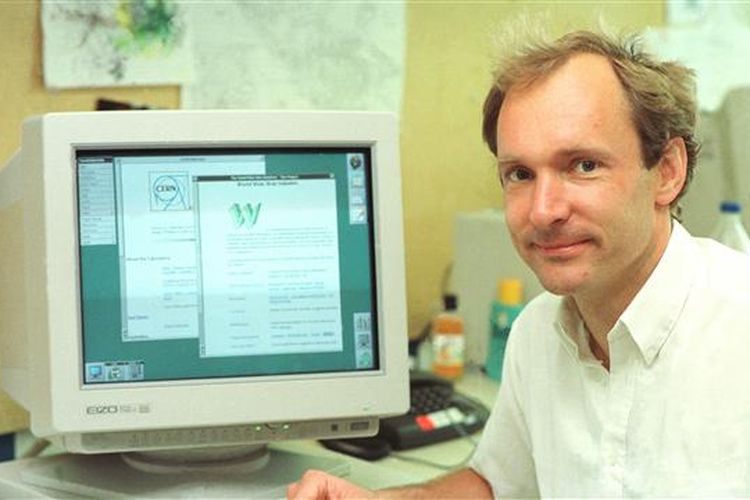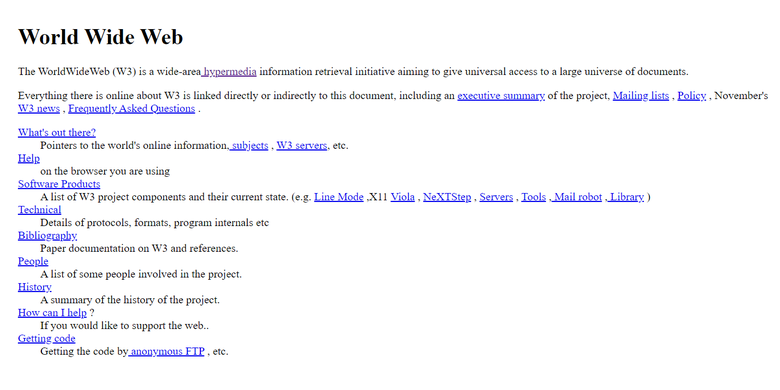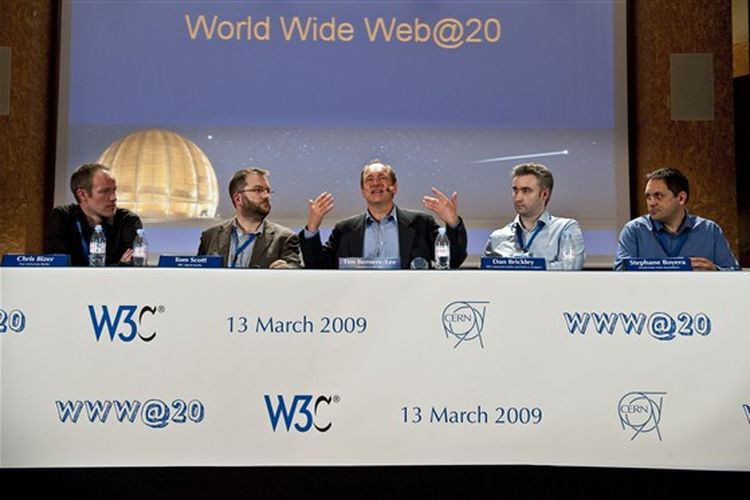History of Tim Berners-Lee
Once upon a time, a young man from London, England, intended to create a project to facilitate the process of sharing information between scientists at universities and institutes spread all over the world.
The project is in the form of hypertext-based software and runs on the internet. He called it the World Wide Web (WWW) or the Web for short as we know it today.
The young man too, Timothy “Tim” Berners-Lee, is often referred to as the “Father of the Internet.”
The project created by Tim opens the door to various activities that are now commonly done via the internet, from seeking information and entertainment, communicating and socializing, to filling coffers.
The web has changed the lives of many people, including its creators themselves. After releasing the Web source code to the public, Tim’s life also took a 180-degree turn. He became a world-famous man who was awarded a series of prestigious awards.
He was awarded the Nobel Prize in computing, was named one of the most important figures of the 20th century by Time magazine and received the Order of Merit from Britain’s Queen Elizabeth II.
Although his creations were widely appreciated, there was a time when Tim was sad to see how his creations were used.
Create a Web-driven by despair
Tim was born and grew up in a family close to technology. Both his parents are known to work as computer scientists to develop the Ferranti Mark 1, the world’s first electronic computer.
He was educated at Queen’s College majoring in Physics. In 1976, Tim graduated and earned a Bachelor of Arts Hons (I) Physics. The honorary degree shows that Tim has an impressive academic achievement.
A few years after graduating, he went on to work at the European Organization for Nuclear Research (CERN). This is where it all started.
At that time, while working as a research partner at CERN in 1984, Tim wanted to create a software that could facilitate and facilitate easier exchange of documents or information between researchers around the world.
Since the internet was growing rapidly at that time, he saw his job would be more difficult if he did not create this software in the future.
Then came the idea of the Team to unite the existing technology in order to build a large information documentation system.

Finally, in 1989, Tim made a software project proposal according to his vision. The proposal was submitted to his manager, Mike Sendall, and accepted. Sendall said the project the Team proposed was “dubious, but exciting.”
Later, the team’s proposal was given the name of the Web or in full the World Wide Web (WWW), which is known to this day.
Actually, in 1980, Tim also tried to make a software prototype with a similar concept called “Enquire”. However, the proposal was rejected and never published.
World’s first browser and site
Long story short, Tim succeeded in realizing the World Wide Web project in the form of the world’s first web browser. The browser is named WorldWideWeb with a writing format without spaces.
In December 1990, Tim also created the world’s first website at info.cern.ch. The first post on the site was dedicated to explaining the World Wide Web project.
Visitors can learn more about hypertext, the technical details for creating their own web pages, and even explanations about how to find information on the Web. To this day, the world’s first site can still be visited at the following link.

WWW. naming drama
Before settling on the WWW name, Tim wanted to name his project with three other names, namely “The Information Mine”, “Mine of Information” and “The Information Mesh”.
However, the three names were ultimately not used for several personal reasons. In the book Weaving the Web written by Tim, the 65-year-old reveals the reasons why the three names were not chosen.
“The Mine of Information” is judged to be too precise as its nickname if it is abbreviated as “TIM”, (T)he (I)information (M)ine. Then, Mine of Information also failed to be used because it formed the abbreviation “MOI”. In French, “MOI” means “me”.
The two names seemed too possessive to Tim, one referring to his nickname and the other being the first-person singular.
In fact, Tim has a vision that the software project can be used by many people around the world.
The Information Mesh also failed to use because the word “mesh” in the name has the same pronunciation as the word “mess” which means “chaos” in English.
As if believing that name is a prayer, Tim really wanted to give it a name that fits the vision of the project he created. Finally, the World Wide Web was chosen as the name of the project.
The team revealed, the name World Wide Web is most suitable to be pinned to emphasize the decentralized form of the WWW. He wants the web to be a place where everything can be connected with anything and is global.
Equally interesting, Tim also insisted that the WWW be written in the “World Wide Web” format instead of “Worldwide Web”. In fact, “worldwide” is actually a valid noun in English.
“I also know that worldwide is in the dictionary. However, WWW must be spelled as three separate words, so the acronym is three separate “Ws” without hyphens,” said the WWW‘s father.
the World Wide Web can be interpreted as Waring Wera Wanua.
The World Wide Web is said to be one of the most important inventions of the 20th century. Even Time magazine in 1999 named Tim as one of the most important figures in the 20th century thanks to his invention.
However, Tim is reluctant to patent his creation. Because of that decision, he never directly benefited from the web.
Instead of patenting it, Tim prefers to release the source code of the WorldWideWeb browser to the public domain. According to him, the WWW must be open source.
The team is right that the Web can thrive if it’s not constrained by patents, fees, royalties, or other controls. That way, he every Internet user can create their own products or services on the Web.
Sure enough, 30 years since its creation, the web is now inhabited by blog sites, government, news portals, to the shelters of giant technology companies such as Facebook, Amazon, Google, and so on.
Founding W3C and WWWF
After releasing the source code of the Web to the public, Tim spent most of his life maintaining and overseeing the growth of the web, by founding the World Wide Web Consortium (W3C) and the World Wide Web Foundation.
Because, he knows the power of the Web that can radically change government, business, society. He also once imagined, the WWW that he created could actually be a world-destroyer if it fell in the wrong hands.
“For people to want to make sure the web serves humanity, we have to pay attention to what people build on it,” Tim told Vanity Fair.
Therefore, Tim founded W3C in October 1994. This consortium was founded to develop technologies (specifications, guidelines, software and tools) to direct the web to its full potential.
The team also founded the World Wide Web Foundation in 2009. The WWWF was founded to ensure that the web is used for the benefit of mankind by establishing it as a fundamental right and global public good.
The team also often encourages global openness of government data and fights for rights such as network neutrality, privacy, and web openness.

Sad to see WWW
Since 30 years ago, the WWW has grown rapidly. At first, the web created by Tim only functioned as a passive technology, only readable and minimal interaction between users.
From 1990 to 2005, most internet users only acted as recipients of the information. Then came the era of Web 2.0, where the web was transformed into a forum for reading and writing for internet users, which was driven by the existence of social networks.
As a result, internet users can create and share their own content. In this era of Web 2.0, Tim also saw how his technology was misused.
He also saw firsthand how giant technology companies violated the use of user data that was founded on Tim’s creation. For example, such as the Cambridge Analytica scandal by Facebook.
This scandal is one of the cases on the web that makes Tim sad.
Facebook admits it exposed more than 80 million user data to political research firm Cambridge Analytica, for use in Donald Trump’s bid to win the 2016 US election.
In addition, in 2012, Facebook also ran an experiment to nearly 700,000 users through the news feed to find out whether Facebook can affect their emotional state. This experiment was carried out without the knowledge of the users.
The Facebook scandal deviated from Tim’s vision of creating the WWW as an open and democratic platform for all. As the one who started all of this, he was overcome with sadness.
“I was devastated,” said Tim describing his feelings watching his technology being misused.
Today, the online world is dominated by a handful of giant tech companies that are developing “capitalism surveillance” systems by exploiting user data for advertising purposes.
Seeing this phenomenon, Tim did not budge. He prepared a counterattack to restore the heyday of the web, namely by promoting the concept of “data sovereignty” for every internet user.
The team has also founded the startup “Inrupt.com”, a company whose vision is to create a new system called “pods”, which is a place to store personal online data.
The team wants complete control over internet users’ data in their own hands, not the tech giants.
Received an award from Queen Elizabeth II
For his services in creating the web, Tim was awarded various awards and honors. For example, in 2004, Tim was knighted by Queen Elizabeth II. He is also often called by the frill “Sir” in his name.
Queen Elizabeth II also presented Sir Tim Berners-Lee with the Order of Merit in 2007. The Order of Merit is a special sign of honor bestowed upon by the Queen personally. Recipients are also limited to only 24 people who are still alive.
In addition, Sir Tim was also awarded the ACM AM Turing Prize in 2017, for the invention of the World Wide Web, the first web browser, and the basic protocols and algorithms that enabled the Web to thrive.
The Turing Prize, also known as the Nobel Prize in Computing, is considered one of the most prestigious awards in the field of Computer Science.
TimBL Profile
- Full name: Timothy John Berners-Lee
- Nickname: Tim, TimBL, Sir Tim
- Place and date of birth: London, 8 June 1955
- Age: 65 Years
- Parents: Conway Berners-Lee (father) and Mary Lee Woods (mother)
Education :
- Emanuel School, London (1969-1973)
- The Queen’s College, University of Oxford, England, BA Hons (I) Physics (1973-1976).
Established organization :
- Chairman and founder of the World Wide Web Consortium (W3C)
- Founder of the World Wide Web Foundation (WWWF)
Other awards :
- Kilby Foundation’s “Young Innovator of the Year” Award (1995)
- Electronic Freedom Foundation’s Pioneer Award (2000)
- Japan Prize, the Science and Technology Foundation of Japan (2002)
- Millennium Technology Prize (2004)
- UNESCO Niels Bohr Gold Medal Award (2010)